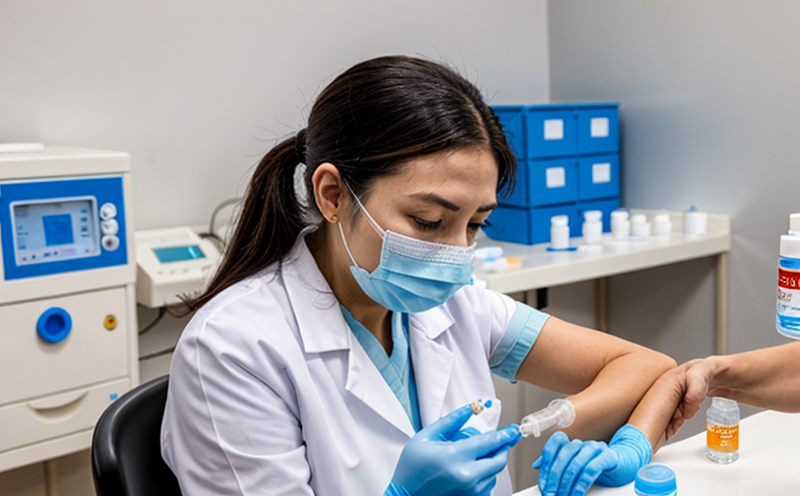WHO Potency Testing of DTP Vaccine
The World Health Organization (WHO) potency testing of the Diphtheria, Tetanus and Pertussis (DTP) vaccine is a critical procedure ensuring the safety, efficacy, and quality of pharmaceuticals. This stringent test evaluates the concentration of active ingredients in the vaccine to ensure it meets international standards set by WHO and other regulatory bodies.
The DTP vaccine is one of the most widely used vaccines globally due to its effectiveness against three serious diseases: diphtheria, tetanus, and pertussis (whooping cough). Ensuring that the potency of this vaccine is accurate is paramount to public health. The WHO standards for potency testing are based on internationally recognized protocols which help to ensure consistency in manufacturing processes across different countries.
The test involves several steps including sample preparation, reconstitution, dilution, and titration using a highly sensitive method such as the agar plate assay or microtiter plate enzyme-linked immunosorbent assay (ELISA). The primary focus is on the quantification of diphtheria toxoid, tetanus toxin fragment C, and pertussis antigens.
The WHO recommends that potency testing should be conducted by laboratories accredited according to ISO/IEC 17025 standards. This ensures that the laboratory has the necessary expertise, facilities, and quality management systems in place to carry out accurate tests. The results of these tests are crucial for vaccine manufacturers as they provide critical data needed for batch release and marketing authorization applications.
The significance of WHO potency testing lies not only in its role within regulatory compliance but also in its contribution to global public health efforts. By ensuring that vaccines meet the highest standards, this process helps protect populations from preventable diseases, especially in regions where access to healthcare is limited.
| Step | Description |
|---|---|
| Sample Preparation | The vaccine sample is collected and prepared according to specified protocols. This includes ensuring that the sample is free from contaminants and is representative of the batch being tested. |
| Dilution | The vaccine sample is diluted to appropriate concentrations for titration, which helps in achieving accurate quantification of the active ingredients. |
| Titration | This involves determining the exact amount of antigen present by using a standardized procedure. The results are expressed as units per milliliter (U/mL). |
The accuracy and precision of WHO potency testing are essential for maintaining public trust in vaccines. Any deviation from these standards could lead to ineffective or unsafe products being distributed, which can have severe consequences.
Understanding the importance of this test also underscores the need for robust quality management systems within laboratories performing such tests. Compliance with international standards like ISO/IEC 17025 ensures that each step in the testing process is conducted consistently and accurately.
Why It Matters
The WHO potency testing of DTP vaccine is essential for several reasons:
To ensure compliance with international regulatory requirements.
To maintain the safety and efficacy of vaccines being distributed globally.
To support public health initiatives aimed at preventing diseases such as diphtheria, tetanus, and pertussis.
To facilitate transparent communication between vaccine manufacturers and regulatory authorities.
Accurate potency testing not only meets legal obligations but also enhances confidence in the vaccine supply chain. It helps identify potential issues early on, allowing for corrective actions to be taken promptly before they affect broader populations.
In summary, WHO potency testing of DTP vaccines plays a vital role in safeguarding public health by ensuring that every batch released is safe and effective according to established scientific standards.
Scope and Methodology
| Parameter | Description |
|---|---|
| Vaccine Sample Collection | Collection of samples from a batch to be tested, ensuring they are representative. |
| Dilution Factor Calculation | Determination of appropriate dilution factors based on expected potency levels. |
| Titration Procedure | Method used to determine the exact amount of active ingredient present in the vaccine. |
| Data Analysis | Analyzing titration results against reference standards provided by WHO. |
| Batch Release Decision | Based on test outcomes, deciding whether a batch can be released for distribution. |
The methodology employed in WHO potency testing is stringent and follows strict guidelines set forth by international bodies. These include adherence to ISO/IEC 17025 standards which ensure that all aspects of the test—from sample preparation to final analysis—are conducted under controlled conditions.
Using advanced techniques like ELISA enhances accuracy, allowing for precise quantification even at low concentrations. This level of precision is crucial given the small quantities involved in vaccine production and distribution.
Quality and Reliability Assurance
Regular calibration of instruments to ensure accurate measurements.
Use of standardized reference materials for consistency checks.
Ongoing training for staff on current best practices in vaccine potency testing.
Annual audits by independent bodies to verify adherence to quality standards.
By implementing these measures, laboratories can maintain high levels of reliability and trustworthiness throughout their operations. Regular calibration ensures that all instruments are operating correctly, while the use of standard reference materials allows for cross-checking between different batches or even different labs performing similar tests.
Ongoing training programs keep staff updated on any changes in protocols or technologies that could affect test results positively. Annual audits serve as external quality controls, providing objective feedback on performance and areas needing improvement.
These practices contribute significantly to the overall reliability of WHO potency testing, ensuring that the data produced is both accurate and trustworthy. This trust is crucial not just for regulatory compliance but also in building confidence among healthcare providers and the general public regarding vaccine safety and effectiveness.





